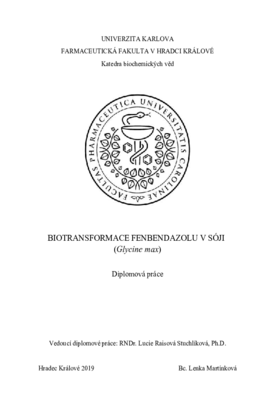Biotransformace fenbendazolu v sóji (Glycine max)
Biotranformation of fenbendazole in soya (Glycine max)
diplomová práce (OBHÁJENO)

Zobrazit/
Trvalý odkaz
http://hdl.handle.net/20.500.11956/110666Identifikátory
SIS: 194033
Kolekce
- Kvalifikační práce [6960]
Autor
Vedoucí práce
Oponent práce
Matoušková, Petra
Fakulta / součást
Farmaceutická fakulta v Hradci Králové
Obor
Odborný pracovník v laboratorních metodách
Katedra / ústav / klinika
Katedra biochemických věd
Datum obhajoby
24. 9. 2019
Nakladatel
Univerzita Karlova, Farmaceutická fakulta v Hradci KrálovéJazyk
Čeština
Známka
Výborně
Klíčová slova (česky)
anthelmintika, biotransformace, sója, LC, MSKlíčová slova (anglicky)
anthelmintics, biotransformation, soya, LC, MSUniverzita Karlova Farmaceutická fakulta v Hradci Králové Katedra biochemických věd Kandidát: Bc. Lenka Martínková Školitel: RNDr. Lucie Raisová Stuchlíková, Ph.D. Název diplomové práce: Biotransformace fenbendazolu v sóji (Glycine max) Veterinární léčiva jsou používána ve velkém množství v novodobém chovatelství pro léčbu a prevenci zvířecích chorob. Anthelmintika podávaná zvířatům vstupují do životního prostředí primárně stolicí nebo močí. Po vyloučení mohou léčiva přetrvávat v životním prostředí a ovlivňovat necílové organismy. Rostliny jsou schopné přijímat xenobiotika, včetně léčiv a detoxikovat je biotransformací. Detoxikace léčiva však představuje pouze biotransformace léčiva na netoxické a stabilní metabolity a jejich následná akumulace v rostlinách. Z tohoto důvodu je velmi důležitá znalost biotransformačních cest léčiva v rostlinách. Rostliny sóji, případně plody, jsou totiž dále využívané v zemědělství jako krmivo pro dobytek a absorbovaná anthelmintika včetně jejich metabolitů mohou vstupovat dále do potravního řetězce. Výsledky ukázaly, že fenbendazol vstupuje do rostlin, které jsou ho schopny biotransformovat. Zjistili jsme rozdíly v metabolitech mezi kořeny, listy, semeny a lusky sóji.
Charles University Faculty of Pharmacy in Hradec Králové Department of Biochemical Sciences Candidate: Bc. Lenka Martínková Supervisor: RNDr. Lucie Raisová Stuchlíková, Ph.D. Title of diploma thesis: Biotransformation of fenbedazole in soya (Glycine max) Veterinary drugs are used in large amounts in modern husbandry for treatment and prevention of diseases in animals. Anthelmintics administered to animals enter into environment primarily through its excretion in faeces or urine. Following excretion, drugs may persist in the environment and impact non-target organisms. Plants are able to uptake xenobiotics, including drugs, and detoxify them via biotransformation. However, only drug biotransformation into non-toxic and stable metabolites and their consequent accumulation in plants represent drug detoxification. For that reasons, knowledge of biotransformation pathways of drug in plants is very important. Soybean plants, eventually seeds, are further used in agriculture as feed for cattle and absorbed anthelmintics including their metabolites can enter the food chain. The results showed that fenbendazole entered plant and enzymatic systems of plant were able to biotransform fenbendazole via several reactions. We found differences in the metabolites between the roots, leaves, seeds and pods of soybean.
